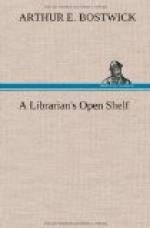A B C D E F G H I J K L Totals
Men 6 64 10 .. .. .. 37 20 3 1 9 4 154 Boys 38 63 28 .. 4 3 9 6 5 .. .. 3 159 Women 12 67 14 4 .. .. 20 21 2 1 2 5 148 Girls 33 69 34 .. .. .. 5 3 3 .. .. 2 149 Total 89 263 86 4 4 3 71 50 13 2 11 14 610
Col. A: Sent or Told by Teacher
Col. B: Sent or Told by Friend
Col. C: Sent or Told by Relative
Col. D: Sent or Told by Clergyman
Col. E: Sent or Told by Library Assistant
Col. F: Through Reading Room
Col. G: Saw Building
Col. H: Saw Sign
Col. I: Saw Library Books
Col. J: Saw Bulletin
Col. K: Saw Article in Paper
Col. L: Sought Library
It will be seen that the vast majority of those questioned were led to the library by some circumstance other than the simple desire to find a place where books could be obtained. Of more than six hundred persons whose answers are here recorded only fourteen found the library as the result of a direct search for it prompted by a desire to read. In a majority of the other cases, of course, perhaps in all of them, the desire to read had its part, but this desire was awakened by hearing a mention of the library or by seeing it or something connected with it. These determining circumstances fall into two classes, those that worked through the ear and those that operated through the eye.
Those who heard of the library in some way numbered 449, while those who saw it or something connected with it were only 147—an interesting fact, especially as we are told by psychologists that apprehension and memory through sight are of a higher type than the same functions where exercised through hearing. Probably, however, this difference was dependent on the fact that the thing heard was in most cases a direct injunction or a piece of advice, while the thing seen did not act with similar urgency. There are some surprises in the table. For instance, only four persons were sent directly to libraries by persons employed therein. Doubtless the average library assistant wishes to get as far from “shop” as possible in her leisure hours, but it is still disappointing to find that those who are employed in our libraries exercise so little influence in bringing persons to use them. The same thing is true of the influence of reading rooms. In many of the branch libraries in New York there are separate reading rooms to which others than card-holders in the library are admitted, and one of the chief arguments for this has been that the user of such a room, having become accustomed to resort to the library building, would be apt to use the books. Apparently, however, such persons are in the minority. No less disappointing is the slight influence of the clergy. Only four persons report this as a determining influence and these were all women connected with a branch which was formerly the parish library of a New York church.




